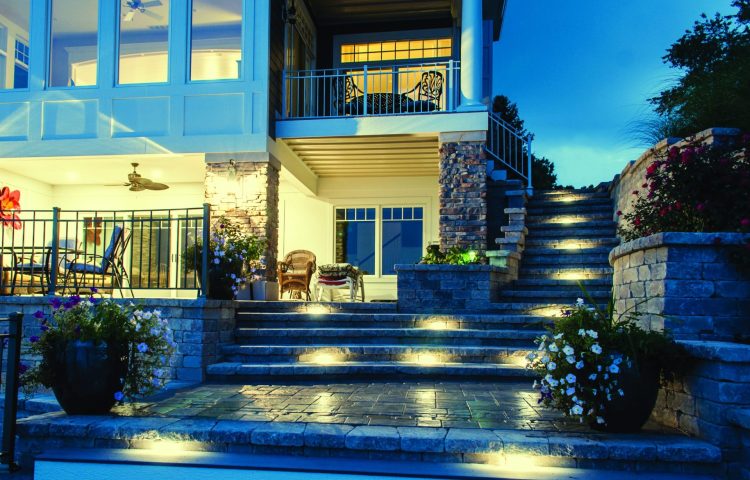
Where to Buy
Common Questions
About Integral Lighting
Where is Integral Lighting made?
All Integral Lighting fixtures are proudly designed, manufactured, shipped and supported in Pennsylvania, USA.
Why does your patented design still get knocked off?
We hear this one every day.
Like many other enterprises, the landscape lighting industry is frequently imitated by off shore companies, as well as our own neighbors. Integral Lighting is committed to reinvesting resources into product and service enhancements… not battling the 20+ companies who can’t think for themselves.
Patent law never worked for independent innovators. We patented our fixture and its mode of installation so that everyone recognizes Integral Lighting as the inventor of “the original hardscape light.”
What is the Integral Lighting trademark?
Our registered trademark, Integral Lighting, distinguishes us from the imitators and knock-off products.
A trademark is a sign or label which differentiates a given manufacturers products from those of others. When you see the Integral Lighting trademark, it guarantees the source of the product you demand. Additionally, when you see Integral Lighting, you can choose with greater certainty that you are purchasing a product held to the highest quality standards, those set forth by Integral Lighting.
Of course, in this modern capitalist economy, imitators will attempt just about anything… including the exploitation and unauthorized use of our registered trademark, Integral Lighting. If you suspect this happening either online or in a store, please notify us immediately at 800-861-1364.
What materials are used for Integral Lighting fixtures?
Integral Lighting utilizes non-corrosive materials to ensure many years of trouble-free service.
The body of our lighting fixtures are constructed of solid metals, such as solid copper, solid brass, stainless steel or heavy duty aluminum. Our Pavelux® fixtures are molded from UV resistant polycarbonate for durability as strong as your stone’s surface.
LED components are overmolded utilizing a process with renewable materials… 80% vegetable oils.
Our final fixture assembly is controlled and monitored for aesthetic appearance as well as performance. A final inspection by quality control is completed prior to packaging.
Are Integral Lighting fixtures UL certified?
Yes. Integral Lighting is a UL Listed Product.
Underwriters Laboratories has set forth the Standards for Safety in Landscape Lighting through the UL 1838 standard. Our facility and product are inspected quarterly to ensure that you are supplied with consistency according to UL 1838 Low Voltage Lighting Systems.
The National Electrical Code, as well as laws in the majority of states, require that lamps and fixtures be tested by a recognized, independent safety-testing agency before they can be legally sold and installed. Electricians in some areas will refuse to install non-UL fixtures.
When considering lighting fixtures, look for the term “UL Listed.” Do not be fooled by statements like “All fixtures are manufactured from UL-approved components.”
Our fixtures conform to UL standards and are tested as a complete unit, thus, bearing the UL mark.
We have invested in processes to ensure your safety and satisfaction and have been a UL Listed facility for over 30 years in the USA and Canada.
How do you handle support and service after the sale?
Personalized service is our passion.
Our experienced support staff has assisted thousands of homeowners and installers with issues in the field. We recognize that every job and installation has unique requirements, and we will do our best to resolve any issues that may arise.
Call our office at 800-861-1364 for design advice, installation assistance, and troubleshooting.
What is your typical shipping turnaround time?
Integral Lighting fixtures are manufactured in Pennsylvania, USA. Between our state of the art facilities and committed employees, we have complete control over our extensive inventory.
We strive to ship all orders within 24-48 hours.
In the unfortunate event that your requested model or finish is not in stock for immediate shipping, we will notify you with an expected ship date.
Why is Integral Lighting the #1 choice for hardscape lighting?
At Integral Lighting, we spend our time and money on creating an unforgettable hardscape lighting experience.
We invented the “original” fixture that revolutionized the hardscape industry and we reinvented the way that service and support are delivered. Recognizing that every project and installation is unique, we offer the most options, the most LED outputs and the most finishes in the hardscape lighting industry.
Our company values shine in every fixture we build, and in every service we provide. As an intentionally small Pennsylvania company, we have remained committed as an American manufacturer for over 30 years. This strategy allows us to pass along benefits that multinational companies cannot offer…
Choose the leader in hardscape lighting innovation… Integral Lighting.
Bulbs And Lamps
Can I use a lower wattage bulb with Integral Lighting?
Yes. We have several options for our IL6.xxx and IL18.xxx fixtures and you can order them directly online.
LED replacement lamps are also available for your Xenon fixtures. These lamps are T5 Wedge Base and fit into the existing socket for an easy replacement.
Do you have a replaceable LED lamp for my Xenon fixtures?
Yes. We offer a T5 Wedge Base LED lamp that is designed with five LEDs for a full 360° light distribution. These lamps fit easily into the existing socket on our IL6.xxx and IL18.xxx fixtures.
How long should my bulbs last?
If your system has been installed with proper attention to voltage, the rated life for our bulbs are as follows:
Approximate hours are based on the manufacturers testing, and is rated when 50% of the said bulbs fail.
Many factors may have an effect on a bulb lasting the rated life. Voltage is the number one detail, and is required to be checked upon installation. We can help you troubleshoot your system if you believe that you are not achieving a satisfactory bulb life.
How do I ensure proper lamp life?
The key component to ensuring proper lamp and LED life is voltage. Checking your system with a voltmeter is the only way to confirm that your voltage is correct.
What effect does voltage have on lamp life?
LED and lamp life are directly related to the voltage supplied to the fixture. Excessive voltage generates excess heat and will shorten the life of your LED or lamp.
Correctly sizing the transformer and taking voltmeter readings are imperative to ensure your fixtures operate as warranted.
Voltage effects on LED and lamp life…
These are approximate values as the actual life varies on many factors.
Where do I purchase replacement bulbs for Integral Lighting?
We make it easy for you to obtain original lamps at a fair price for Integral Lighting fixtures. Replacement Bulbs allows you to view our selection, purchase directly online, and have them delivered to your front door.
Why does my first lamp fail regularly?
We often hear that the transformer is located too close to the first fixture, thus, the first fixture is being exposed to a voltage spike when the system turns on. Consider cabling to your farthest fixture and returning to the first (closest) fixture. We always recommend at least 30 feet of cable between the transformer and first fixture.*
Replacement of burned out bulbs in a timely manner is critical in low voltage systems since the remaining voltage is distributed to the remaining lamps. This may produce premature failure in the remaining lamps.
*If your installation benefits from our Electronic LED Transformer, there are no distance recommendations between the transformer and first fixture. As the LED Electronic Transformer regulates the voltage at 11.5vAC, it eliminates potential voltage spikes from occurring.
Can I use a brighter bulb in Integral Lighting?
It is not recommended. Our fixtures have been tested and listed with Underwriters Laboratories for safety. The fixture was designed for optimum performance with the supplied lamp.
Cable And Connections
Do I need to notch the concrete block to install my fixture?
Generally speaking, no. The idea behind our fixture is to remove the sawing and cutting that was traditionally required to install a light into a wall. You may find it necessary to cut for channeling the wire where a gap does not accommodate your layout.
How long are your fixture leads?
Each fixture is supplied with a 72″ wire lead, attached directly to either our T5 Wedge Base socket or overmolded LED package.
The wire is 18/2 and should be connected to your feed wire as close as practical using watertight connectors.
How do I minimize voltage drop?
The closer your incandescent fixtures are placed to the transformer, the higher their voltage (and wattage). The farther away you place the fixture, the lower the voltage it will receive. If a cable run is too long, or if too many lights are being powered by a single transformer, noticeable voltage drop may occur.
Voltage drop causes the lights farthest from the transformer to become dimmer than the other lights.
Voltage drop can be minimized in various ways …
Voltage drop actually works to your advantage if differences in lamp brightness levels add a desired look and feel to your installation. Remember… bulbs with lower voltage will last longer, requiring less replacement.
Do I need to use low voltage cable with the electronic transformer?
Yes. 12/2 gauge low voltage cable is recommended.
How do I connect the fixture to the feed cable?
Proper low voltage connections are essential for a successful installation.
We recommend a splice which is joined by a waterproof connector, such as King or Ideal Brand. These connectors are filled with silicone or a dielectric material to provide protection to the splice from the elements. Please consult the manufacturers guidelines for detailed instructions.
What gauge cable should I use?
As a general rule, use a minimum gauge of 12/2 when your total run of cable is within 100′ of the transformer.
What cable is used to install Integral Lighting?
Low voltage (12 volt) lighting cable is utilized. This cable is designed for shallow burial directly in the soil, only six inches deep. Low voltage cable has UV inhibitors in the jacket making it sunlight resistant.
Dimming
Are Integral Lighting fixtures dimmable?
Yes, all Integral Lighting Xenon and LED fixtures are dimmable.
Generally, low voltage (12vAC) landscape lighting transformers are equipped with built-in timer and/or photocell controls. Many power supplies can be controlled by the following devices when the on-board controls are bypassed or disabled.
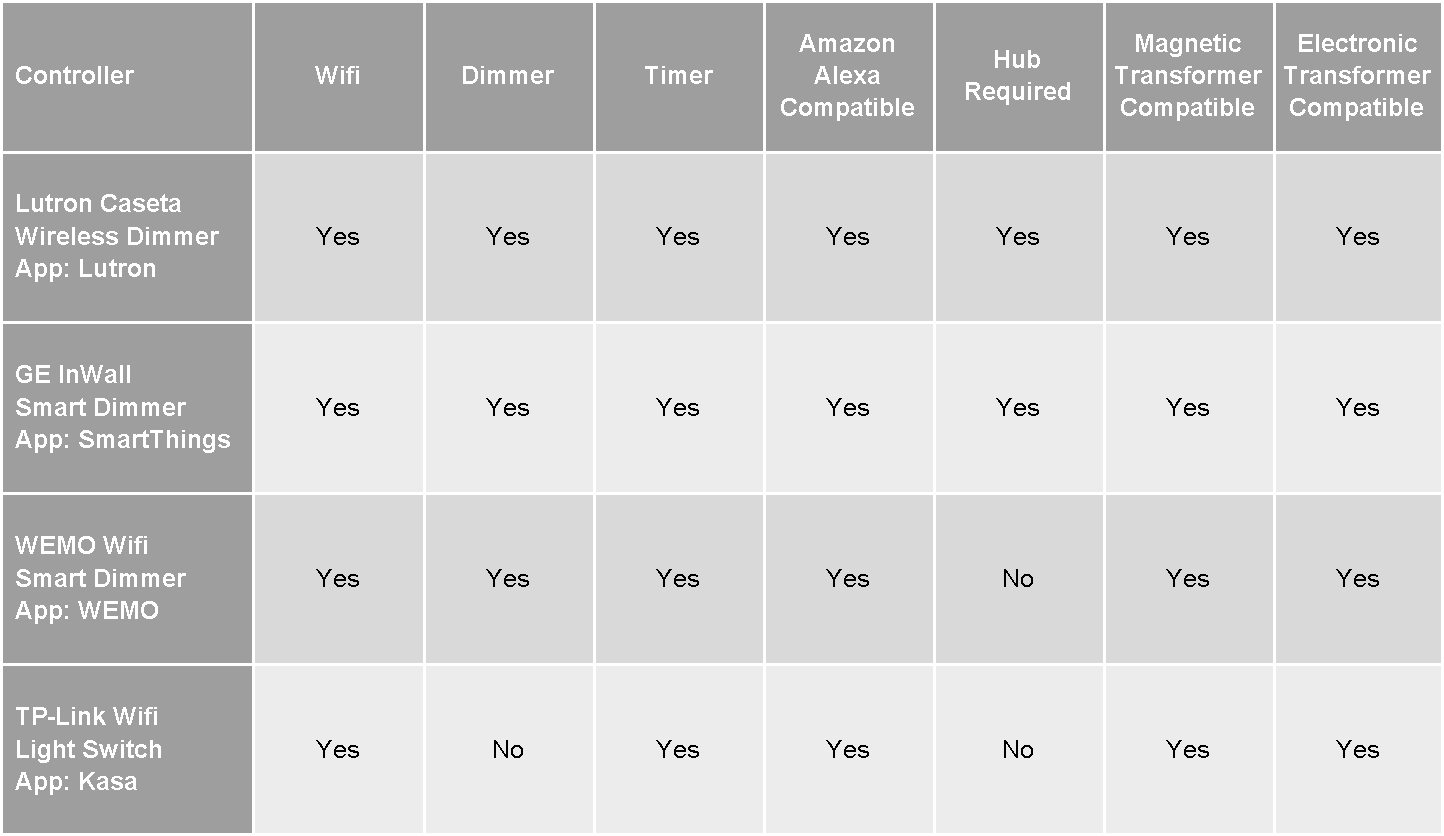
All trade names are registered trademarks of respected manufacturers listed.
Many controllers have minimum and maximum load requirements to maintain safety and operate properly. The controls listed above require 20 to 30 watts minimum but vary depending on manufacturer specifications.
The home control and LED industries are advancing at a rapid pace of innovation. This information is subject to change. When controls are desired, consult your equipment manufacturer for compatibility between power supplies, load requirements and fixture brands.
For more information regarding the use of dimmers with low voltage lighting systems, please read the Lutron Dimmer White Paper.
What effect does dimming have on incandescent fixtures?
Typically, you can expect to increase the projected lamp life due to the reduction of voltage at the fixture. Additionally, you will notice a slight change in the color output as voltage is reduced … the incandescent fixture emits a slightly warmer light.
Will dimming an LED change the color output?
Reducing the voltage to an LED does not change the color output, or warmth, of the fixture. LEDs are designed to emit the same color at all points of voltage.
If your goal is to alter the output of your LED fixture, we do offer various options. Filters are available for our .500 LED fixtures to alter the output between 2700K warm white (incandescent equivalent), 3000K pure white (halogen equivalent), and 4200K cool white (fluorescent equivalent). Our .550 LED fixtures emit 2400K ultrawarm white, which is comparable to the warmth of candlelight.
Installation Advice
How many lights do I need?
Design and layout are up to you!
Start by determining your desired placement. We recommend spacing six to eight feet between fixtures, depending on the type of atmosphere you want to create. For areas that need to be well-lit, such as steps or for security reasons, consider spacing your fixtures closer together or using a higher wattage lamp. For ambiance or accent lighting, consider spacing your light fixtures further apart or using a lower wattage lamp.
If your design includes steps, start by lighting the steps adequately, then place fixtures in the surrounding walls to expand the feel of night lighting as you desire.
You are welcome to email us your plans, and our lighting designer will make recommendations for fixture type and spacing.
How do I size a transformer for my lighting installation?
Calculate the total wattage of all lighting fixtures that will be hooked up to your transformer. The total wattage will be the minimum required output of the transformer.
When sizing a transformer for an LED installation, use the wattage consumed by each lamp, not the wattage output or brightness equivalent.
The industry recommends utilizing 80% of your transformer’s capacity for optimal system life.
Example: a 60 watt transformer would be ideal for the lighting installation below.
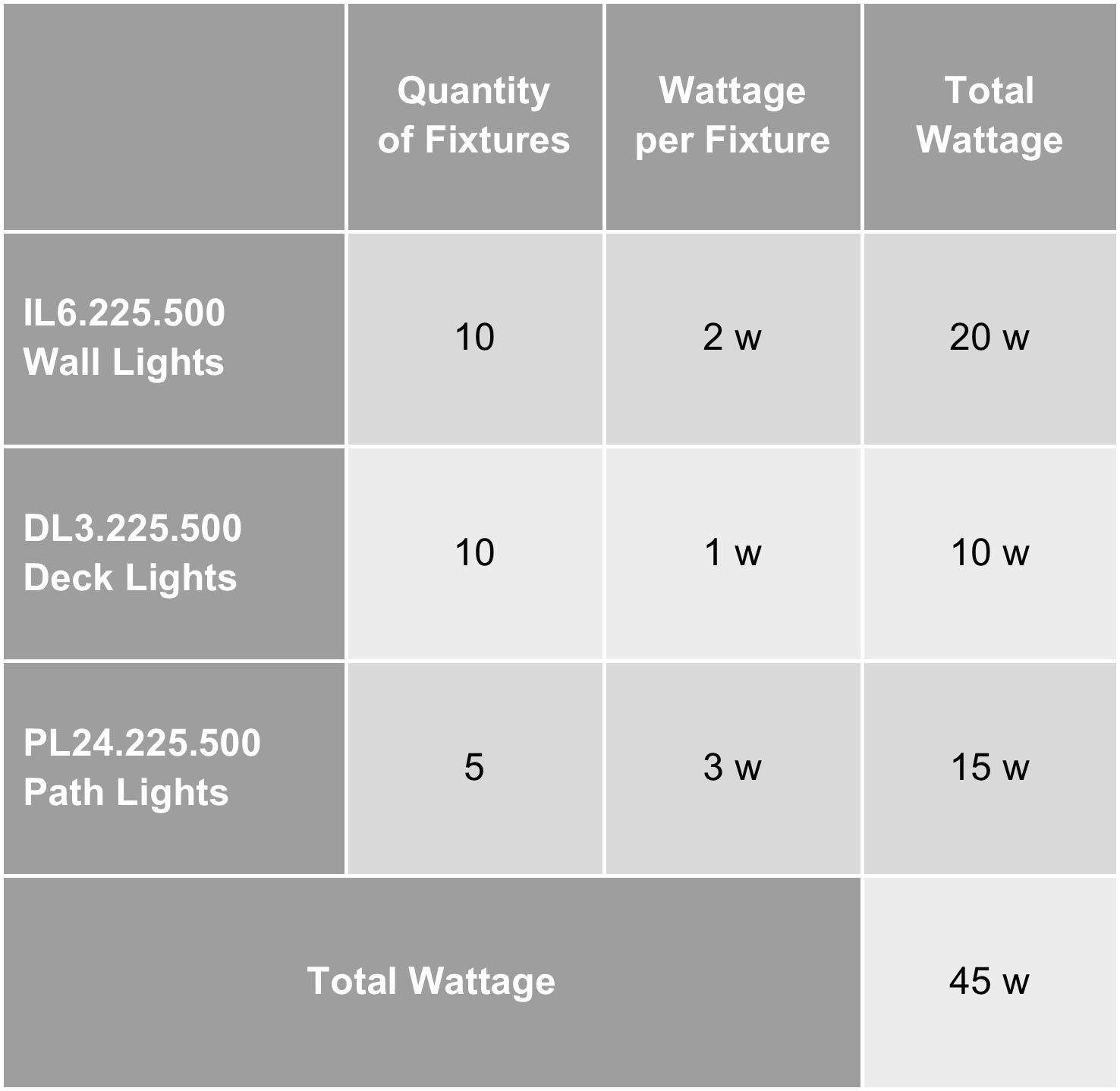
How do I mount a low voltage transformer?
Your power supply should be mounted at least 12 inches above ground level. Many transformers are not completely sealed and should have that clearance according to UL 1838.
Do I need to notch the concrete block to install my fixture?
Generally speaking, no. The idea behind our fixture is to remove the sawing and cutting that was traditionally required to install a light into a wall. You may find it necessary to cut for channeling the wire where a gap does not accommodate your layout.
Is Integral Lighting compatible with my existing low voltage lighting?
Yes, Integral Lighting is compatible with existing 12 volt AC installations.
A typical landscape lighting installation operates on 12 volts and is powered by a magnetic transformer. Before making additions to an existing system, consult your transformer rating to ensure that you have enough capacity to power more lighting fixtures. If not, consider the addition of a second transformer or increase your current power supply.
How long are your fixture leads?
Each fixture is supplied with a 72″ wire lead, attached directly to either our T5 Wedge Base socket or overmolded LED package.
The wire is 18/2 and should be connected to your feed wire as close as practical using watertight connectors.
Can I install Integral Lighting on decking materials?
All Integral Lighting LED fixtures are perfect for any and all materials, including wooden decks.
Our fixtures equipped with a Xenon lamp, the IL6.xxx and IL18.xxx, are for strict use in hardscapes only.
Can Integral Lighting be installed into masonry walls or veneer stone walls?
Yes, and we make it easy to insert our fixture using a specially designed pre-installation insert. Our Integrator Mortar Insert saves valuable time during installation and allows for future removal of the fixture in the event that service becomes necessary.
How do I connect the fixture to the feed cable?
Proper low voltage connections are essential for a successful installation.
We recommend a splice which is joined by a waterproof connector, such as King or Ideal Brand. These connectors are filled with silicone or a dielectric material to provide protection to the splice from the elements. Please consult the manufacturers guidelines for detailed instructions.
What gauge cable should I use?
As a general rule, use a minimum gauge of 12/2 when your total run of cable is within 100′ of the transformer.
What cable is used to install Integral Lighting?
Low voltage (12 volt) lighting cable is utilized. This cable is designed for shallow burial directly in the soil, only six inches deep. Low voltage cable has UV inhibitors in the jacket making it sunlight resistant.
Do I need an electrician to install Integral Lighting?
Not necessarily.
Integral Lighting operates on a low voltage (12 volt AC) lighting system. Once you determine the quantity of fixtures desired, the transformer is plugged into a nearby 120 volt receptacle. Low voltage cable is routed throughout the installation and the fixtures are connected with waterproof splices.
We provide detailed instructions with every fixture and toll-free assistance for your convenience.
Call 800-861-1364 if you would like to discuss your project prior to installation.
LED Overmold 2020
What makes your overmolding process sustainable?
Renewable resources are utilized in our overmolding process… 80% vegetable oils.
How can I differentiate overmolded LEDs from potted LEDs?
Look for these differentiating labels on our product packaging, as well as the look of the product itself:
2020 version with overmolded LEDs
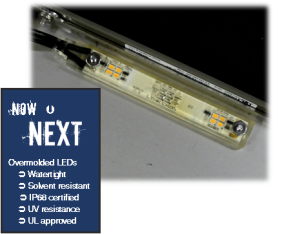
previous version with potted LEDs
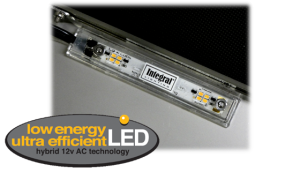
What are the benefits of overmolding?
Made with renewable materials, overmolding provides superior protection from the harshest environments.
How do I obtain a previous version as a replacement?
We have reserved limited stock of our previous version to fulfill warranty and service related issues. If you return an Integral Lighting fixture for warranty, we will replace it with the same LED package to ensure your light output remains equivalent.
Keep in mind that all LED packages degrade slowly in the amount of light output, therefore, we cannot guarantee a perfect match on output brightness.
LEDs
What color output is your LED?
Integral Lighting offers four popular LED options.
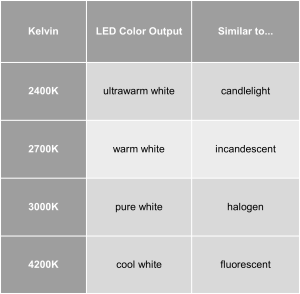
What voltage is required to operate your LED?
Our LED packages are engineered on a 12 volt AC platform. The operating range is 8 – 12.5 volts AC. Optimum performance is achieved when operated at 11.5 volts AC.
What type of LED is used by Integral Lighting?
Integral Lighting utilizes a hybrid 12 volt AC LED. Our LEDs are engineered specifically for use with both magnetic and electronic transformers.
Why did we choose this type of AC LED platform? There are no additional electronic components or drivers required to operate them, which means less can go wrong.
Imitators who have knocked off our design incorporate upwards of 20 individual electronics in each LED. These range from diodes and transistors, to inductors and IC regulators, to electrolytic and ceramic capacitors… all of which are a source for failure in the future.
Why doesn’t Integral Lighting utilize DC LED chips?
Until recently, Direct Current (DC) LEDs were the widely accepted method of converting a fixture to LED. DC LEDs require additional electronics within the system, commonly referred to as “the driver.” This converts the transformers AC power to DC and makes the LED operate.
We worked closely with chip designers to supply a hybrid 12 volt AC LED that requires no conversion of power. Our LED operates on AC voltage.
Simply put, less electronics = less potential failure.
Do your LED fixtures experience voltage drop?
Integral Lighting fixtures are equipped with a 12 volt AC LED package that operates on a voltage range from 8.0 – 12.5 volts. The incredibly low energy consumption of our LEDs virtually eliminates the voltage drop associated with traditional incandescent landscape lighting installations.
Do you have a replaceable LED lamp for my Xenon fixtures?
Yes. We offer a T5 Wedge Base LED lamp that is designed with five LEDs for a full 360° light distribution. These lamps fit easily into the existing socket on our IL6.xxx and IL18.xxx fixtures.
Are Integral Lighting fixtures dimmable?
Yes, all Integral Lighting Xenon and LED fixtures are dimmable.
Generally, low voltage (12vAC) landscape lighting transformers are equipped with built-in timer and/or photocell controls. Many power supplies can be controlled by the following devices when the on-board controls are bypassed or disabled.
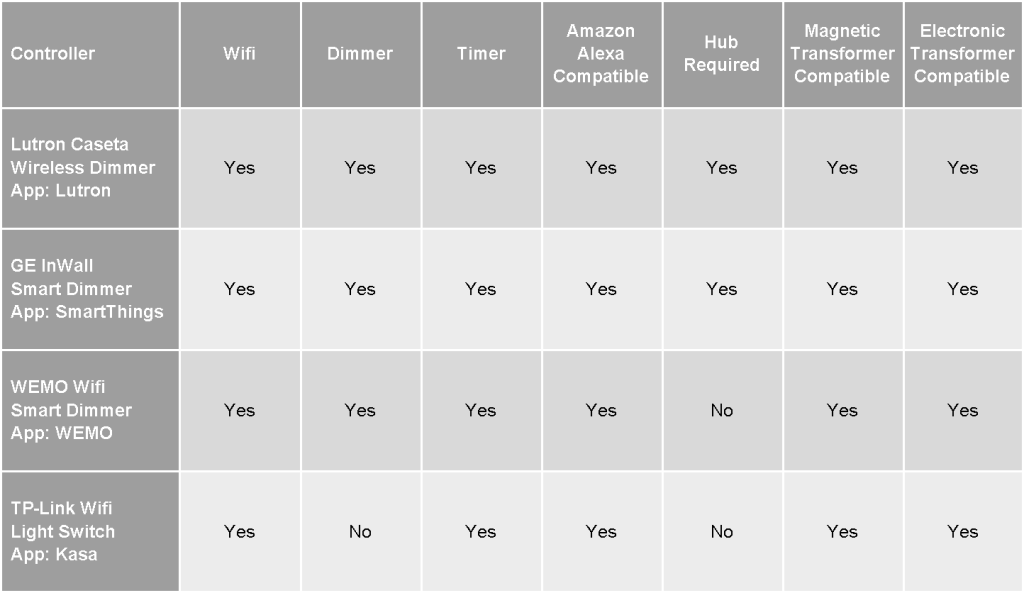
All trade names are registered trademarks of respected manufacturers listed.
Many controllers have minimum and maximum load requirements to maintain safety and operate properly. The controls listed above require 20 to 30 watts minimum but vary depending on manufacturer specifications.
The home control and LED industries are advancing at a rapid pace of innovation. This information is subject to change. When controls are desired, consult your equipment manufacturer for compatibility between power supplies, load requirements and fixture brands.
For more information regarding the use of dimmers with low voltage lighting systems, please read the Lutron Dimmer White Paper.
Do you have an LED that blends with existing incandescent fixtures?
Yes. Integral Lighting offers four LED options, two of which would provide an equivalent incandescent output… 2400K ultrawarm white and 2700K warm white.

What is the life expectancy of your LED?
When installed according to our voltage recommendations, our LED is expected to last for up to 40,000 hours.
Excessive voltage and the consequence of excessive heat is the main culprit of premature failure. It is imperative to confirm your voltage with a volt meter at both the first and last fixture.
Optimum LED performance is achieved at 11.5vAC.
Will dimming an LED change the color output?
Reducing the voltage to an LED does not change the color output, or warmth, of the fixture. LEDs are designed to emit the same color at all points of voltage.
If your goal is to alter the output of your LED fixture, we do offer various options. Filters are available for our .500 LED fixtures to alter the output between 2700K warm white (incandescent equivalent), 3000K pure white (halogen equivalent), and 4200K cool white (fluorescent equivalent). Our .550 LED fixtures emit 2400K ultrawarm white, which is comparable to the warmth of candlelight.
What is an ultrawarm white LED?
The Integral Lighting ultrawarm white LED offers the warmest output available on the market. This LED offers a soft warmth and comfortable inviting feel that once only incandescent lighting could provide. Our ultrawarm white LED is approximately 2400K, dimmable, and compatible with both electronic and magnetic transformers.
Lighting Terminology
AC
AC stands for “Alternating Current.” The flow of electrons switch directions – forward and backward.
Amp / Amperage
Measures the flow of electricity through a wire.
Circuit
An electrical “branch” off the main power supply.
CRI
CRI stands for the “Color Rendering Index” for light quality on a scale of 1 to 100.
DC
DC stands for “Direct Current.” The flow of electrons moves in only one direction.
Efficacy
Energy shown in lumens per watt.
Foot Candles
Measures light on a surface, having the symbol “fc.” One foot candle equals one lumen per square foot.
Kelvin
Colors of the spectrum, having the symbol “K.”
Lamp
The technical term for a light bulb.
LPW
LPW stands for “Lumens Per Watt.”
Lumen
The international measurement for visible, spherical light, having the symbol “lm.”
Lux
Unit of illumination, equivalent to 0.0929 foot candle and equal to the illumination produced by luminous flux of one lumen falling perpendicularly on a surface one square meter.
Multi-tap
A transformer that has the ability to accommodate several voltages.
Parallel Run
A parallel run allows all fixtures to draw current independently of the other fixtures. When one light goes out, the others will stay on.
Photometrics
A measure of a fixture’s actual light output at various distances.
Power Supply
A power supply, otherwise known as a transformer, is generally used with low voltage lighting to “transform” or reduce line voltage to 12 volts. Without a transformer, the lamps would be subjected to excess voltage and would burn out immediately.
Resistance
Electrical pressure on the wire, impairing the flow of electricity.
Splice
To join together two or more wires by interweaving and applying a waterproof connection.
T
A “T” consists of running a low voltage cable to a centralized zone, then running other cables off the “T” to fixtures. It equalizes voltage and removes the error of over exposure at the first lamp.
Transformer
A transformer, otherwise known as a power supply, is generally used with low voltage lighting to “transform” or reduce line voltage to 12 volts. Without a transformer, the lamps would be subjected to excess voltage and would burn out immediately.
Volt
Measures the pressure through a wire.
Voltage Drop
The degree in which voltage is diminished, affecting lamp performance.
Watt
Measures the energy consumed.
Wicking
The migration of water and electrolytes under wire insulation. This moisture travels from where the wire has been cut including splice points, socket connections, and transformer terminals.
Xenon
Xenon gas is available in our atmosphere at approximately 0.087 PPM. The Integral Lighting IL6.xxx, IL18.xxx and PL24.xxx are available with Xenon gas filled bulbs.
12v
12v stands for “12 volt,” low voltage lighting. It is safe, efficient and easy to install. Most low voltage lighting fixtures are smaller in size, allowing for the light to be seen but not the fixture itself.
Parts And Repairs
My fixture isn’t working. Is there anything you can do?
Yes. Please fill out this form (including pictures), and we can likely repair or replace it. All warranty and repair issues are determined on a case-by-case basis.
How do I obtain warranty service for Integral Lighting products?
If you are an end user, please contact your installer or Authorized Distributor for service.
In the unfortunate event that your installer or distributor have gone out of business, please fill out this form (including pictures), or call us at 800-861-1364. We will make every attempt to ensure that your concern is handled in a professional manner in accordance with our Lifetime Limited Warranty.
How do I purchase replacement parts?
If you have lost a screw or scratched a faceplate, we make it easy. Please locate your model number which is found on the inside of the removeable faceplate. (example IL4.250.500)
Call our office at 800-861-1364. We will promptly process your request.
Can I change the color of my Integral Lighting faceplates?
Your fixtures are installed but they don’t match the wall. Now what? We will accommodate most changes at no additional cost. We understand that installations look differently once completed. Contact your local distributor or call 800-861-1364 to obtain exchange information.
The following hardscape lighting fixtures have a removable and replaceable faceplate:
What is your Guaranteed Lifetime Service?
Our Guaranteed Lifetime Service is above and beyond our Lifetime Limited Warranty. It extends the coverage of all of our fixtures and guarantees service when you require it. In particular, your LED fixtures are extended to 15 years (based on 40,000 hours or 6 hours per day operation) when you follow our recommended guidelines for installation.
Our Guaranteed Lifetime Service is available to the original purchaser of the product and is easily validated by registering your purchase and installation.
Where do I purchase replacement bulbs for Integral Lighting?
We make it easy for you to obtain original lamps at a fair price for Integral Lighting fixtures. Replacement Bulbs allows you to view our selection, purchase directly online, and have them delivered to your front door.
How do you handle support and service after the sale?
Personalized service is our passion.
Our experienced support staff has assisted thousands of homeowners and installers with issues in the field. We recognize that every job and installation has unique requirements, and we will do our best to resolve any issues that may arise.
Call our office at 800-861-1364 for design advice, installation assistance, and troubleshooting.
Patents And Trademarks
Why does your patented design still get knocked off?
We hear this one every day.
Like many other enterprises, the landscape lighting industry is frequently imitated by off shore companies, as well as our own neighbors. Integral Lighting is committed to reinvesting resources into product and service enhancements… not battling the 20+ companies who can’t think for themselves.
Patent law never worked for independent innovators. We patented our fixture and its mode of installation so that everyone recognizes Integral Lighting as the inventor of “the original hardscape light.”
What is the Integral Lighting trademark?
Our registered trademark, Integral Lighting, distinguishes us from the imitators and knock-off products.
A trademark is a sign or label which differentiates a given manufacturers products from those of others. When you see the Integral Lighting trademark, it guarantees the source of the product you demand. Additionally, when you see Integral Lighting, you can choose with greater certainty that you are purchasing a product held to the highest quality standards, those set forth by Integral Lighting.
Of course, in this modern capitalist economy, imitators will attempt just about anything… including the exploitation and unauthorized use of our registered trademark, Integral Lighting. If you suspect this happening either online or in a store, please notify us immediately at 800-861-1364.
Pavelux®
Are roller tampers safe to use on Pavelux®?
ria used in designing the product.
Modern roller tampers exert about 14 ft lbs per inch and may crack the fixture, therefore, we are recommending that direct contact be avoided with this type of compactor.
We are working diligently to improve the molded parts to meet current expectations of installation methods utilizing new roller tamper technology. At this time, we recommend avoiding using roller tampers over the fixture during installation.
Visit pavelux.com for more information.
Can I install Pavelux® in existing asphalt?
Yes, Pavelux® can be installed in existing asphalt. You can cut the asphalt and drop the fixtures in place, but would absolutely need to fill the space around them with polymeric sand. The space could not be filled with anything else, because of freeze and thaw cycles.
Visit pavelux.com for more information.
Can I use Pavelux® with tumbled pavers?
After speaking with a group of contractors who have installed Pavelux®, along with the fixture designer, we can offer the following advice on fitment to various manufacturers of paver stones…
The fixture itself is designed to a full dimension be it 4″, 6″ or 8″ in length as some block manufacturers maintain full dimension. In the case of tumbled stone, a minor adjustment may be needed to achieve the desired effect and maintain design. That being said, a minor trimming of the end opposite the cord is acceptable by method of sawing. Some installers actually remove the sharp end edge at the top of the fixture to have it blend with the tumbled paver.
The maximum amount that can be removed from the end opposite the cord is as follows…
Visit pavelux.com for more information.
In how many sizes is Pavelux® available?
Pavelux® LED paver inserts are available in three lengths which insert easily into your hardscape accent border with no cutting or drilling. Each size is stocked in both 3000K pure white and 2400K ultrawarm white LED color outputs.
Visit pavelux.com for more information.
Is Pavelux® affected by extreme temperatures?
Our Pavelux® fixtures were tested under various temperature conditions and supply voltages.
Pavelux® fixtures themselves at temperatures of 140° Fahrenheit and supply voltage of 12.5 volts AC demonstrated that the LED board operated well under the manufacturer’s guidelines for maximum thermals. With this being said, excessive voltage has the most effect on operating temperature and is obviously a critical element in overheating LED fixtures. This is why we always remind installers to administer 12 volts or less, as LEDs have the same life characteristics as an incandescent lamp.
We also took into account that different paver surfaces are affected by the sun at different temperatures, for instance, black asphalt has a higher surface temperature than white concrete. With this in mind, lighting fixtures are typically not lit during the heat of the day, as they are meant to light the night.
As for the housing, the material utilized in our Pavelux® fixtures is UV stabilized polycarbonate and will not be affected by an increase or decrease in temperature or sun exposure.
Visit pavelux.com for more information.
Is Pavelux® UL certified?
Yes. Our Pavelux® LED paver inserts are UL 1838 Low Voltage Landscape Lighting certified in the United States and Canada.
Visit pavelux.com for more information.
Are Pavelux® fixtures waterproof?
Yes. Pavelux® LED paver inserts are waterproof with completely encapsulated, integrated LED packages. The fixtures are IP67 certified, which means that they are fully protected from dust and can withstand immersion between 15 centimeters and 1 meter (or 3.28 feet) in depth for up to 30 minutes.
Visit pavelux.com for more information.
What is Pavelux®?
Pavelux® is the next generation of LED paver lighting.
Our minimalist design is molded from UV resistant polycarbonate for durability as strong as your stone surface. Choose from three standard lengths and two choices of popular LED color outputs.
Our design is intentionally simple, allowing for insertion between pavers and requiring no cutting or drilling for installation. The fixture itself is virtually invisible during the day, reducing impact on your design without sacrificing lighting effects at night.
Visit pavelux.com for more information.
Practical Conversion Factors
Light Calculations
Approximate Lumen Output = Candle Power X 12.57
Footcandles X 10.764 = Lumens / Square Meter = Lux
Lumens X .07958 = Spherical Candle Power
Lux X .0929 = Foot Candles
Power Calculations
Power = Voltage X Current
Watts = Volts X Amps
Current = Power / Voltage
Amps = Watts / Volts
Unit Conversions
Inches = Millimeters / 25.4
Millimeters = Inches X 25.4
Feet = Meters / .3048
Meters = Feet X .3048
Centigrade = .556 X (Fahrenheit – 32)
Fahrenheit = 1.8 X (Centigrade + 32)
Voltage Drop Calculations
Calculation: V = I x L x (R/1000) x 1.004
V = Voltage Drop
I = Current
L = Length of Conductor in Feet
R = Resistance of Conductor per 100 Feet
Purchasing
How do I purchase replacement parts?
If you have lost a screw or scratched a faceplate, we make it easy. Order Replacement Parts or call 800-861-1364. We will promptly process your request.
Where do I purchase replacement bulbs for Integral Lighting?
We make it easy for you to obtain original lamps at a fair price for Integral Lighting fixtures. Replacement Bulbs allows you to view our selection, purchase directly online, and have them delivered to your front door.
How do you handle support and service after the sale?
Personalized service is our passion.
Our experienced support staff has assisted thousands of homeowners and installers with issues in the field. We recognize that every job and installation has unique requirements, and we will do our best to resolve any issues that may arise.
Call our office at 800-861-1364 for design advice, installation assistance, and troubleshooting.
What is your typical shipping turnaround time?
Integral Lighting fixtures are manufactured in Pennsylvania, USA. Between our state of the art facilities and committed employees, we have complete control over our extensive inventory.
We strive to ship all orders within 24-48 hours.
In the unfortunate event that your requested model or finish is not in stock for immediate shipping, we will notify you with an expected ship date.
Quality Assurance And Safety
Has Integral Lighting ever had a product recall?
We are pleased to announce that we have never had a product recall. Our quest for safe, top quality product remains our focus.
All Integral Lighting fixtures are UL 1838 Low Voltage Landscape Lighting certified for your safety. Ongoing facility and fixture inspections by Underwriters Laboratories ensures that we are supplying products held to their standards.
Is Pavelux® UL certified?
Yes. Our Pavelux® LED paver inserts are UL 1838 Low Voltage Landscape Lighting certified in the United States and Canada.
Visit pavelux.com for more information.
What materials are used for Integral Lighting fixtures?
Integral Lighting utilizes non-corrosive materials to ensure many years of trouble-free service.
The body of our lighting fixtures are constructed of solid metals, such as solid copper, solid brass, stainless steel or heavy duty aluminum. Our Pavelux® fixtures are molded from UV resistant polycarbonate for durability as strong as your stone’s surface.
LED components are overmolded utilizing a process with renewable materials… 80% vegetable oils.
Our final fixture assembly is controlled and monitored for aesthetic appearance as well as performance. A final inspection by quality control is completed prior to packaging.
Are Integral Lighting fixtures UL certified?
Yes. Integral Lighting is a UL Listed Product.
Underwriters Laboratories has set forth the Standards for Safety in Landscape Lighting through the UL 1838 standard. Our facility and product are inspected quarterly to ensure that you are supplied with consistency according to UL 1838 Low Voltage Lighting Systems.
The National Electrical Code, as well as laws in the majority of states, require that lamps and fixtures be tested by a recognized, independent safety-testing agency before they can be legally sold and installed. Electricians in some areas will refuse to install non-UL fixtures.
When considering lighting fixtures, look for the term “UL Listed.” Do not be fooled by statements like “All fixtures are manufactured from UL-approved components.”
Our fixtures conform to UL standards and are tested as a complete unit, thus, bearing the UL mark.
We have invested in processes to ensure your safety and satisfaction and have been a UL Listed facility for over 30 years in the USA and Canada.
What is the quality of Integral Lighting’s powder coated fixtures?
Integral Lighting utilizes an eight-step pre-treatment process to ensure that you end up with only the finest product. Most pre-treatment processes do not remove enough particulates to ensure maximum adhesion. The pre-treatment processes and final rinse of filtered freshwater ensures removal of earlier washes and wash particulates.
Our powder coating process is PCI 3000 certified.
Additionally, we promote environmental responsibility in various ways…
Transformers - Electronic
How do I size a transformer for my lighting installation?
Calculate the total wattage of all lighting fixtures that will be hooked up to your transformer. The total wattage will be the minimum required output of the transformer.
When sizing a transformer for an LED installation, use the wattage consumed by each lamp, not the wattage output or brightness equivalent.
The industry recommends utilizing 80% of your transformer’s capacity for optimal system life.
Example: a 60 watt transformer would be ideal for the lighting installation below.
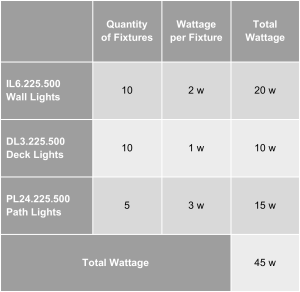
How do I mount a low voltage transformer?
Your power supply should be mounted at least 12 inches above ground level. Many transformers are not completely sealed and should have that clearance according to UL 1838.
Do I need to take voltage readings with electronic transformers?
It’s not necessary. Our Electronic LED Transformer automatically supplies 12 volts AC and adjusts for the amount of demand. The actual output will vary depending on the number of fixtures but will not exceed 12 volts.
When utilizing a magnetic transformer, it is imperative to take voltage readings. As magnetic transformers do not regulate voltage, accurate readings are necessary to ensure your fixtures perform as warranted.
Can I mount my low voltage transformer inside?
No. Generally speaking, low voltage transformers are listed and labeled for “Outdoor Use Only.”
If your installation requires an indoor transformer, consult your local electrical codes… you may be able to purchase a low voltage power supply locally for that specific use. Remember that if you are using a photocell, you may have to make other provisions for controlling the outdoor lighting.
How many LEDs can the electronic transformer handle?
Our Electronic LED Transformer typically powers 1 to 20 Integral Lighting LED fixtures on a cable run of less than 100′. If your job requires a larger quantity of fixtures, or a longer cable run, please call our office at 800-861-1364 to discuss your project with us. We will help you determine which transformer will work best for your lighting.
How close can an LED be mounted to the electronic transformer?
Fixtures can be positioned within 1′ to 50′ of the receptacle. Our Electronic LED Transformer automatically adjusts the load, therefore eliminating any worry of overpowering a fixture mounted too close to the power supply.
Do I need to use low voltage cable with the electronic transformer?
Yes. 12/2 gauge low voltage cable is recommended.
Can I use your electronic transformer to power AC and DC lights?
Our Electronic LED Transformer delivers 12 volts AC. It is specified for AC fixtures only and is compatible with all Integral Lighting 12vAC LED fixtures. If you purchased fixtures manufactured by companies other than Integral Lighting, please consult the manufacturer prior to installation.
Do fixtures dim with further distances (as with magnetic transformers)?
Yes. Longer runs of cable still affect the transmission of voltage. If this is the case and you require a longer run or the lights are too dim, consider a magnetic transformer in lieu of the electronic transformer.
Does the electronic transformer require a minimum load to turn on?
In general, electronic transformers typically require a minimum load to turn on. Our unit is designed to power a single fixture if that is what your job requires.
With that being said, it also has limitations. This transformer is designed to power 1 to 20 Integral Lighting LED fixtures on cable runs up to 100′. For larger installations, consider using a magnetic transformer or call 800-861-1364 to discuss your project with us.
What is the purpose of an electronic transformer?
Many installations are quite compact and require only a few Integral Lighting fixtures.
The power supply is often plugged into the closest receptacle, whereby a typical magnetic transformer supplies excess voltage because of its close proximity to the LED fixtures. Our goal was to introduce a self-regulating power supply for LED installations and eliminate the headache of excess voltage and premature failure.
Specify our Electronic LED Transformer for smaller LED installations.
Transformers - Magnetic
How do I install the photocell in my stainless steel transformer?

How do I set the timer in my stainless steel transformer?
Move the tiny blue tabs on the dial outward to turn ON, and inward to turn OFF.
Each segment represents 15 minutes, and there are a total of 96 tabs (representing 24 hours in a day). Before using the timer, it is best to push-in all tabs around the timer dial. You may then pull each 15-minute tab toward the outside of the dial for the times that you want the timer to switch ON.
Setting the current time:
Now that you have set the times that you want the timer to switch ON or OFF, you need to set the current time of day by turning the dial CLOCKWISE until the current time of day is set against the arrow-head.
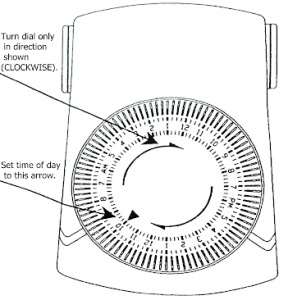
How do I size a transformer for my lighting installation?
Calculate the total wattage of all lighting fixtures that will be hooked up to your transformer. The total wattage will be the minimum required output of the transformer.
When sizing a transformer for an LED installation, use the wattage consumed by each lamp, not the wattage output or brightness equivalent.
The industry recommends utilizing 80% of your transformer’s capacity for optimal system life.
Example: a 60 watt transformer would be ideal for the lighting installation below.

How do I mount a low voltage transformer?
Your power supply should be mounted at least 12 inches above ground level. Many transformers are not completely sealed and should have that clearance according to UL 1838.
Why does my transformer turn on, off, and then back on after a period of time?
Most low voltage transformers are equipped with thermal protection. If your power unit is undersized (overloaded) it is probably overheating and causing the thermal protection to shut down the unit. Consider using a larger transformer or splitting the load to an additional unit.
Can I mount my low voltage transformer inside?
No. Generally speaking, low voltage transformers are listed and labeled for “Outdoor Use Only.”
If your installation requires an indoor transformer, consult your local electrical codes… you may be able to purchase a low voltage power supply locally for that specific use. Remember that if you are using a photocell, you may have to make other provisions for controlling the outdoor lighting.
Why is my transformer making a humming noise?
Low voltage transformer cores are built from thin steel laminations that are stuck together. The cycling on and off over time may have loosened the laminations, creating a slight vibration. This is typical of units that have not been encapsulated with epoxy during the manufacturing process. It does not mean that your power supply will fail.
How do I minimize voltage drop?
The closer your incandescent fixtures are placed to the transformer, the higher their voltage (and wattage). The farther away you place the fixture, the lower the voltage it will receive. If a cable run is too long, or if too many lights are being powered by a single transformer, noticeable voltage drop may occur.
Voltage drop causes the lights farthest from the transformer to become dimmer than the other lights.
Voltage drop can be minimized in various ways …
Voltage drop actually works to your advantage if differences in lamp brightness levels add a desired look and feel to your installation. Remember… bulbs with lower voltage will last longer, requiring less replacement.
How do I ensure proper lamp life?
The key component to ensuring proper lamp and LED life is voltage. Checking your system with a voltmeter is the only way to confirm that your voltage is correct.
Voltage
What’s the difference between a digital and analog voltmeter?
A voltmeter is an instrument used for measuring current, voltage and resistance. Electronic power supplies require an analog voltmeter for accurate voltage measurement. Magnetic power supplies require a digital voltmeter for accurate voltage measurement. In either case, 12 volts or less is advised.
Here is a quick comparison between digital voltmeters and analog voltmeters…

What voltage is required to operate your LED?
Our LED packages are engineered on a 12 volt AC platform. The operating range is 8 – 12.5 volts AC. Optimum performance is achieved when operated at 11.5 volts AC.
Do I need to take voltage readings with electronic transformers?
It’s not necessary. Our Electronic LED Transformer automatically supplies 12 volts AC and adjusts for the amount of demand. The actual output will vary depending on the number of fixtures but will not exceed 12 volts.
When utilizing a magnetic transformer, it is imperative to take voltage readings. As magnetic transformers do not regulate voltage, accurate readings are necessary to ensure your fixtures perform as warranted.
Do your LED fixtures experience voltage drop?
Integral Lighting fixtures are equipped with a 12 volt AC LED package that operates on a voltage range from 8.0 – 12.5 volts. The incredibly low energy consumption of our LEDs virtually eliminates the voltage drop associated with traditional incandescent landscape lighting installations.
Power Calculations
Power = Voltage X Current
Watts = Volts X Amps
Current = Power / Voltage
Amps = Watts / Volts
Voltage Drop Calculations
Calculation: V = I x L x (R/1000) x 1.004
V = Voltage Drop
I = Current
L = Length of Conductor in Feet
R = Resistance of Conductor per 100 Feet
How do I minimize voltage drop?
The closer your incandescent fixtures are placed to the transformer, the higher their voltage (and wattage). The farther away you place the fixture, the lower the voltage it will receive. If a cable run is too long, or if too many lights are being powered by a single transformer, noticeable voltage drop may occur.
Voltage drop causes the lights farthest from the transformer to become dimmer than the other lights.
Voltage drop can be minimized in various ways …
Voltage drop actually works to your advantage if differences in lamp brightness levels add a desired look and feel to your installation. Remember… bulbs with lower voltage will last longer, requiring less replacement.
What effect does voltage have on lamp life?
LED and lamp life are directly related to the voltage supplied to the fixture. Excessive voltage generates excess heat and will shorten the life of your LED or lamp.
Correctly sizing the transformer and taking voltmeter readings are imperative to ensure your fixtures operate as warranted.
Voltage effects on LED and lamp life…
These are approximate values as the actual life varies on many factors.
Why does my first lamp fail regularly?
We often hear that the transformer is located too close to the first fixture, thus, the first fixture is being exposed to a voltage spike when the system turns on. Consider cabling to your farthest fixture and returning to the first (closest) fixture. We always recommend at least 30 feet of cable between the transformer and first fixture.*
Replacement of burned out bulbs in a timely manner is critical in low voltage systems since the remaining voltage is distributed to the remaining lamps. This may produce premature failure in the remaining lamps.
*If your installation benefits from our Electronic LED Transformer, there are no distance recommendations between the transformer and first fixture. As the LED Electronic Transformer regulates the voltage at 11.5vAC, it eliminates potential voltage spikes from occurring.